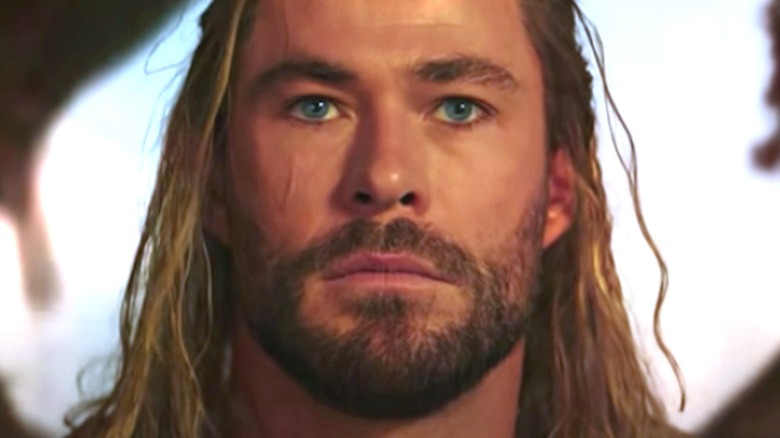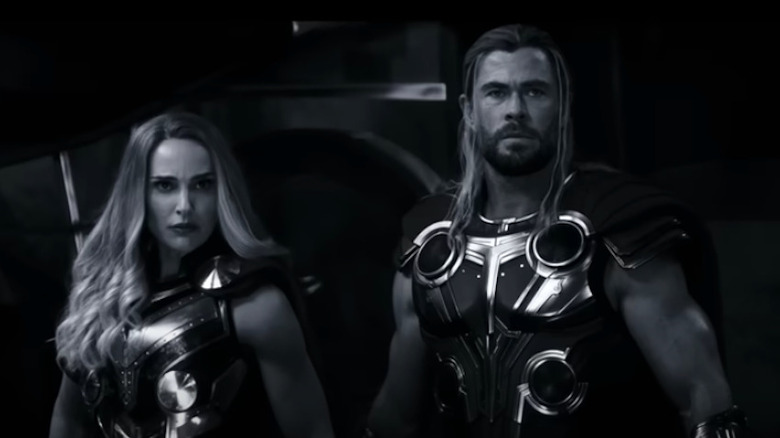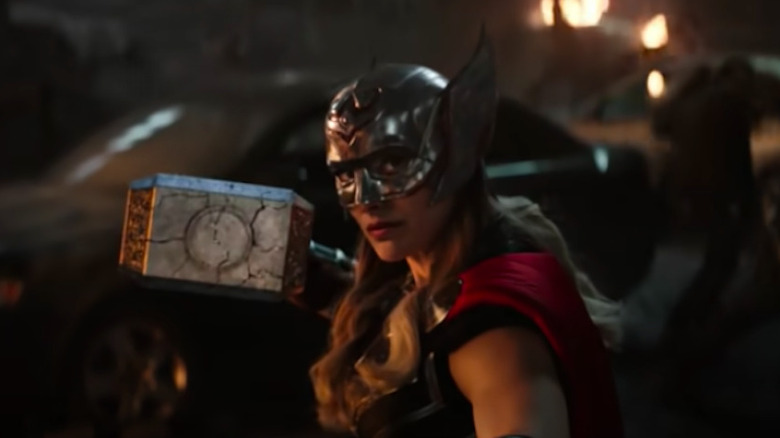Thor: Love And Thunder Finally Explains How Mjolnir Returned
Contains major spoilers for "Thor: Love and Thunder"
Directed by Taika Waititi, "Thor: Love and Thunder" has finally hit theaters, complete with a brand new villain, numerous references to mythology, and some screaming goats. The characters thrive under Waititi's direction, presenting a colorful story that's as entertaining as it is heartfelt. The narrative also reintroduces viewers to Dr. Jane Foster (Natalie Portman), whose presence is instrumental in helping Thor (Chris Hemsworth) and King Valkyrie (Tessa Thompson) defeat an evil that threatens the future of New Asgard.
Ever since the first trailer dropped, fans have been clamoring to find out what leads the astrophysicist to become Mighty Thor, a plotline that has left us with burning questions about Jane's future in the MCU. The film also sees the return of Thor's hammer Mjolnir, the destruction of which forced the hero to forge a new weapon in "Avengers: Infinity War." The hammer is practically a character all its own, providing opportunities to showcase the franchise's signature brand of humor and prompting a reunion that's been eight years in the making. The hammer's resurrection brings about a host of changes, significantly influencing Thor's journey to self-discovery. Without further ado, let's take a look at how Mjolnir's epic comeback shapes "Thor: Love and Thunder."
Thor and Jane's painful breakup
To fully explain Mjolnir's revival, we must first look at the return of Dr. Jane Foster.
After years of letting us wonder, "Thor: Love and Thunder" finally explains why Thor and Jane went their separate ways. Viewers are privy to a bittersweet montage set to ABBA's "Our Last Summer," which shows their romance unravel. For an astrophysicist and a demigod, the pair managed to build a strong foundation for a future together. Everything was good for a while, but the differences in their lives eventually drove a wedge between them. As it turns out, it's not easy building a life with someone who's always running off to face intergalactic threats.
A main theme of the film is that it was Jane who taught Thor about the merits of using his powers to help people, but she also showed him real love and the humanity that comes with it. Thor couldn't cope with his fear of losing her, so he embraced the growing distance in their relationship. In the end, it was Jane who pulled the plug on their romance, one of several traumas that Thor is trying to come to terms with when we first see him at the beginning of the film. Following the events of "Avengers: Endgame," Thor is back to his old self with the help of a strict workout regime and some quality time with the Guardians of the Galaxy. He hasn't seen Jane in years, but that's about to change because she could use Thor's help now more than ever.
Jane seeks a magical solution
Jane's life has changed dramatically since viewers last saw her in "Thor: The Dark World." In Thor's absence, she's had plenty of time to focus on her career. However, an unexpected illness threatens to derail everything she's worked for. Jane has stage 4 cancer and her prognosis isn't looking good. Although Darcy (Kat Dennings) and Dr. Selvig (Stellan Skarsgård) have attempted to convince her to save her energy, Jane has been tirelessly working to find a way to cure herself. It's heartbreaking to see Jane this way. Alone and physically weakened, the image is a far cry from the lively character we've seen in previous films. Reaching the end of her rope, Jane finds herself drawn to tales from Norse mythology.
Although Thor and the other Asgardians aren't immortal, a fact cemented by Loki's (Tom Hiddleston) death at the hands of Thanos (Josh Brolin), they don't fall victim to the same frailties that humans are affected by. Their magic grants them a certain level of invulnerability, including super strength and good health. These aspects of godliness intrigue Jane, but there's more to it than that. Thor's hammer Mjolnir has always been a conduit for this power and it calls out to Jane. Flashbacks demonstrate that this is no accident. As their relationship dwindled, Thor asked Mjolnir to watch over Jane, a magical request that has remained intact. Even after all these years, Thor and Jane are still connected, whether they know it or not.
The hammer chooses a new host
In a last-ditch effort to cure her cancer, Jane travels to New Asgard, which has become a major tourist attraction. While the other visitors are enjoying the rides and authentic Asgardian mead, Jane has other plans. After being destroyed by Hela (Cate Blanchett) in "Thor: Ragnarok," the broken pieces of Mjolnir are on display in a glass case. There's a palpable energy humming in the air as Jane approaches the hammer, which rumbles and sparks as she grows closer, like a long-dormant beast rising from slumber.
Since its destruction, everyone has assumed that Mjolnir was beyond repair. For the relocated Asgardians, the shattered relic reminds them of where they came from and all they've faced since the decimation of their home world. For sightseers, it's the physical embodiment of one of Earth's mightiest heroes. For Jane, it's her last hope for survival, a doorway to a life where her illness is a thing of the past. All this time, Mjolnir was waiting for Jane and she is more than worthy.
As promised, Mjolnir grants Jane the powers of a god, resulting in the effortlessly cool, muscled-up version of the characters fans have seen in trailers. Unfortunately, wielding the hammer isn't enough to save Jane, who dies helping Thor defeat Gor the God Butcher (Christian Bale). Her sacrifice has a profound effect on Thor, who is finally able to accept his past and look towards a brighter future, Mjolnir in hand.



